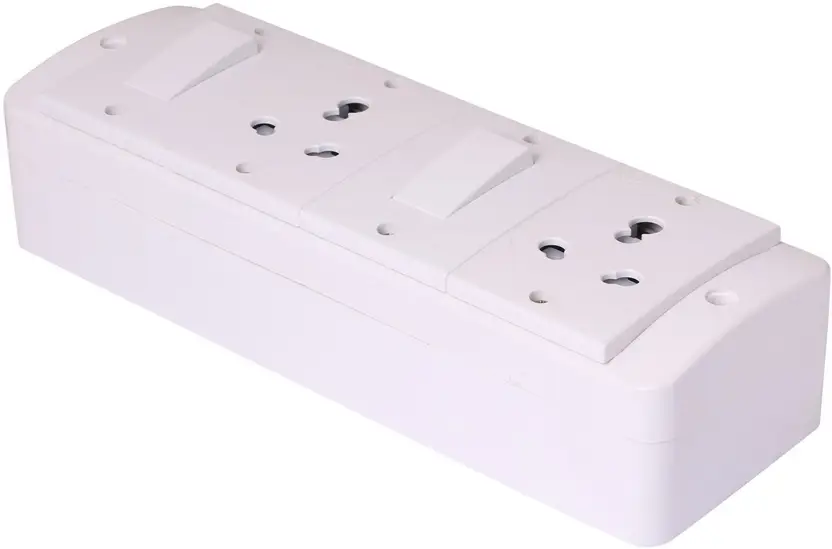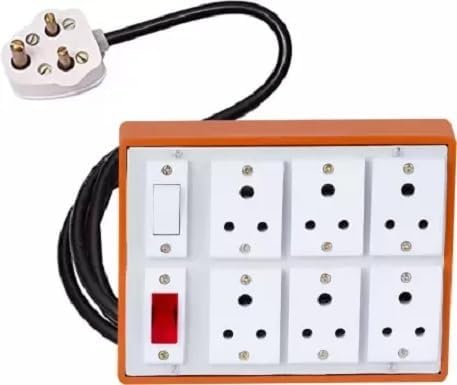⚙️ What is a 2.5 mm Cable and Why Does It Matter?
A 2.5 mm cable refers to the cross-sectional thickness of the copper wire inside the extension board. This thickness allows the wire to:
Handle higher current (up to 20A safely)
Reduce chances of overheating
Deliver consistent power without voltage drop
Last longer under continuous heavy use
In short: Thicker wire = Safer, Stronger, More Reliable.
🏠 Where Should You Use Heavy-Duty Extension Boards?
These types of extension boards are perfect for:
Kitchen appliances – microwaves, OTGs, induction cooktops
Bathroom equipment – geysers, water heaters
Living room setups – TVs with home theatre systems
Offices – computers, printers, UPS, routers
Shops & workshops – tools, air compressors, fridges
🛡️ Key Features to Look for
When shopping for a heavy-duty extension board with 2.5 mm cable, make sure it also includes:
✅ 16A or 25A socket support
✅ MCB or overload protection
✅ Fire-resistant body (metal or strong polycarbonate)
✅ Universal or 3-pin sockets
✅ Master switch and indicator light
✅ ISI/BIS certified components
🔌 Benefits of Using 2.5 mm Cable Extension Boards
| Feature | Benefit |
|---|---|
| 2.5 mm Copper Cable | High current support without overheating |
| Heavy Load Capacity | Suitable for high-wattage appliances |
| Longer Lifespan | Durable even with regular heavy usage |
| Fire Safety | Reduced risk of short circuits & wire burn |
| Voltage Stability | Consistent flow for sensitive electronics |
💬 Final Word
A heavy-duty extension board with 2.5 mm cable is more than just a power accessory — it’s a safety device that protects your expensive appliances and prevents accidents.
Whether you’re setting up your smart home, office workstation, or industrial workspace, always invest in an extension board that matches your power needs — starting with a thick, copper core cable.
Lorem ipsum dolor sit amet, consectetur adipiscing elit. Ut elit tellus, luctus nec ullamcorper mattis, pulvinar dapibus leo.





enovathemes
Thanks for the insightful post! I recently experienced some weird steering behavior, and your explanation on steering angle sensor function and failure symptoms helped me diagnose the issue. Looking forward to trying out the testing methods you mentioned to confirm if it\’s indeed the sensor. Keep up the great work!
enovathemes
This post couldn\’t have come at a better time for me. I\’ve been grappling with an intermittent steering issue, and after reading this breakdown, I\’m convinced it might be the steering angle sensor. Your detailed explanations on symptoms and testing procedures are incredibly helpful. Time to break out the multimeter and get to work!
enovathemes
Great breakdown of the steering angle sensor! As a tech enthusiast, I appreciate the emphasis on testing methods. It\’s not just about identifying the issue but also about empowering car owners to tackle the diagnostics themselves. Your post strikes the right balance between technical details and practical application. Kudos!
enovathemes
Knowledge is power! Understanding the steering angle sensor and its potential failures is crucial for maintaining vehicle safety. Your post does an excellent job of breaking down the technical details in an accessible way. It\’s a must-read for anyone looking to keep their vehicle in top condition and prevent potential steering-related issues. Thanks for sharing this valuable information!